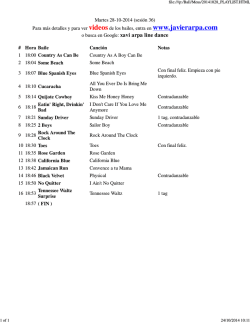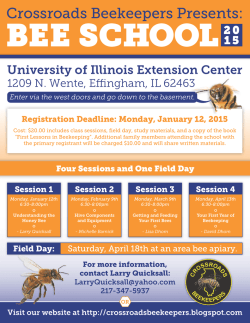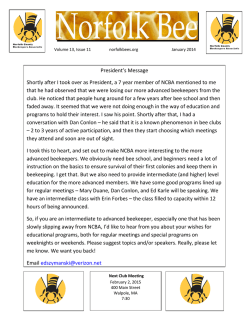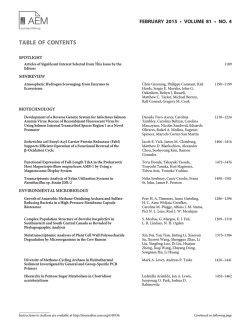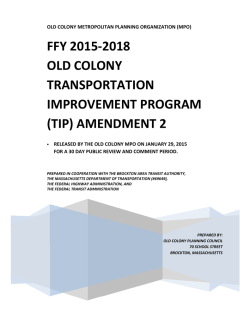
Ann Bernert and Ramesh Sagili, PhD. Oregon State University
Explorations in impacts of fumagillin and tylosin treatments on the honey bee (Apis mellifera L.) midgut microbiome in vivo Ann Bernert and Ramesh Sagili, PhD. Oregon State University, Corvallis, OR Materials and Methods Purpose The purpose of this research project if to identify if tylosin and/or fumagillin decrease levels of symbiotic Lactobacillus species in the honey bee midgut. Image 1: Recollecting marked bees from the mother colony. The economic value of pollination by honey bees in the United States is a $15 billion1 Image 2: Newly emerged bees were painted and released into mother colony to be inoculated with natural hive microbes, painted bees were then recaptured for in vivo experiment Background Information Honey bees are vital to modern agriculture for their economically significant pollination services.1,2 The health of honey bee colonies is essential for maintaining these important services. The honey bee microbiome is a newly recognized and important aspect of colony health.3,4,5 The honey bee microbiome develops appropriate immune responses in the honey bee and helps outcompete pathogenic microbes.3 Symbiotic honey bee microbes inhibit the growth of pathogenic microbes and play an important part in making honey and digesting pollen.6,7 It has been shown that Lactobacillus species are some of these very important symbiotic microbes.2 Tylosin, a treatment for American Foulbrood disease, a bacterial pathogen, and fumagillin for the control of Nosema, a microsporidian pathogen are two commonly used chemicals to combat honey bee diseases.8,9 This research investigates how these chemicals affect the number of Lactobacillus species in the honey bee midgut. Our hypothesis is that tylosin and fumagillin may deplete symbiotic microorganisms in the honey bee midgut. By understanding how these chemicals affect the symbiotic microbes in the honey bee gut, it will be possible to create pathogen control programs with minimal detrimental side effects. Treatments: Concentration was per manufacturers recommended dosage 1) Control, 2) T,ylosin, 3) Fumagillin, 4) Tylosin and Fumagillin In vitro experimentation A well diffusion test using MRS agar, a Lactobacillus specific media, and a solution of honey bee midgut microbes that was spread across the surface of the media in a petri plate. 50 µl of prepared treatment solutions was placed in the well. After 72 hours of incubation, the distance between the bacterial field of growth and the chemical filled well was measured. In vivo experimentation Bees were inoculated with normal hive microflora and then randomly assigned to one of the four treatment groups. Each treatment group was replicated four times. Each sample day, 10 bees were randomly selected, midguts were dissected and plated according to 100x dilution series replicated twice. Bacterial Colony Formation Units were counted after 72 hours of incubation. Ashrafun Nessa – For work coordination and all the guidance with caged bees Ken Johnson & Todd Temple – For help with plate dilution series experiment Ellen Toptizhofer – For the background on experimental design Cameron Jack – For all the help working in the field with the colonies, collecting frames, painting and recollecting bees Many thanks to the undergraduate student worker bees- For the help with sampling and data collection Tylosin reduced Lactobacillus sp. growth both in vitro and in vivo Fumagillin did not affect Lactobacillus sp. in vitro but did decrease Lactobacillus Colony Formation Units in vivo suggesting additional microbial interactions occurring in vivo While these chemicals do decrease the quantity of symbiotic bacteria in honey bee midguts in laboratory settings, they may not deplete Lactobacillus sp. as greatly in a field setting This data suggests treating hives with tylosin and fumagillin should be done in consideration with the effect they have on symbiotic microbes Further research is needed to fully understand the interactions between honey bee treatments and the hive microbiome Results In vitro Experiment Tylosin significantly reduced bacteria from honey bee midguts and fumagillin did not reduce growth. There was no synergistic affect when tylosin and fumagillin were used together Inhibition zone Image 5: Symptom of Nosema infection- the pathogen causes severe energetic distress8 Inhibition zone Image 3: Tylosin, labelled “Tylan”, on left and control plates, labelled “C”, on right Image 4: Fumagillin plates, labelled “Fum”, and fumagillin & tylosin plates, labelled “F+T”, on the right In vivo Experiment The average Colony Formation Units of all replications per treatment (n= 80 per treatment, 160 counts total) was used for graphs 100% 100 90% 90 80% 80 10 6J. Evans, T. Armstrong (2006) Antagonistic interactions between honey bee symbionts and implications for disease. BMC Ecology 6 (4) 0 Control Tylosin Fumagillin Tylosin & Fumagillin Before treatment 0% Control Tylosin 5 days after treatment Fumagillin Tylosin & Fumagillin 12 days after treatment Graph 1: Percent Reduction in Colony Formation Units on Lactobacillus selective media after treatment Lautenbach, R. Seppelt, J. Liebscher, C. Dormann (2012) Spatial and Temporal Trends of Global Pollination Benefit. PLoS ONE 7 (4) e35954. doi:10.1371/journal.pone.0035954 Anderson, T Sheehan, B. Eckholm, B, Mott, G. DeGrandi-Hoffman (2011) An emerging paradigm of colony health: microbial balance of the honey bee and hive (Apis mellifera). Insectes Sociaux 20 10% 2S. 5K. 30 20% Sagili, D. Burgett (2011) Evaluating Honey Bee Colonies for Pollination: A Guide for Commercial Growers and Beekeepers. A Pacific Northwest Extension Publication, PNW 623 Marttila, D. Rios, V. Walker-Sperling, G. Roeselers, I. Newton (2012) Characterization of the Active Microbiotas Associated with Honey Bees Reveals Healthier and Broader communities when Colonies are Genetically Diverse. PLoS ONE 7 (3) e32962 40 30% 1R. 4H. 50 50% References DeGrandi-Hoffman, B. Eckholm, K. Anderson (2012) Honey Bee Health: The potential Role of Microbes. In: Sammataro, D. and Yoder, J., editors. Honey Bee Colony Health: Challenges and Sustainable Solutions. Boca Raton, FL. CRC Press. p. 1-12. 60 60% Image 6: Symptom of American Foulbrood- a spore-forming bacteria9 3G. 70 70% 40% Acknowledgements Conclusion 5 days after treatment 12 days after treatment Graph 2: Comparison of the average Colony Formation Units between treatments at specified sampling times 7F. Reynald, M. DeGiusti, A. M. Alippi (2004) Inhibition of the growth of Ascosphaera apis by Bacillus and Paenibacillus strains isolated from honey. Revista Argentintina de Microbiologia (36) 52-55 8Z. Huang (2012) Effects of Nosema on Honey Bee Behavior and Physiology. eXtension http://www.extension.org/pages/60674/effects-of-nosema-on-honey-bee-behavior-andphysiology#.UzuZP_ldWSo 9A. Flores (2007) Helping Beekeepers Beat American Foulbrood. USDA ARS http://www.ars.usda.gov/is/ar/archive/jul07/bee0707.htm
© Copyright 2026
